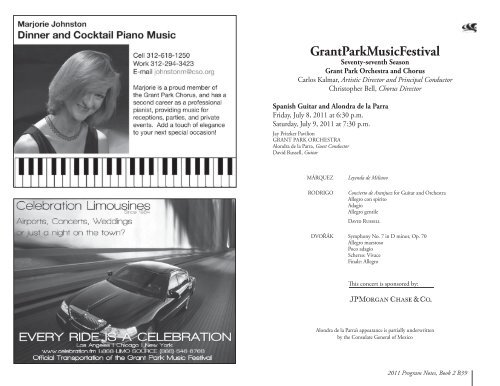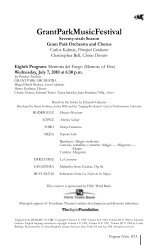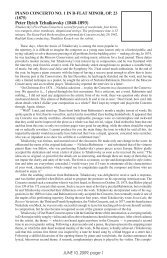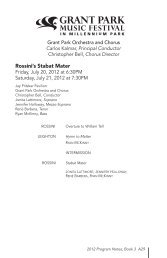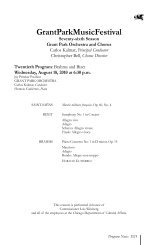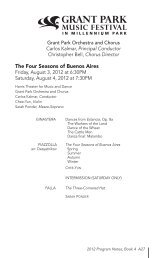2011 Program Book 2 - Spanish Guitar - July 8 & 9.pdf
2011 Program Book 2 - Spanish Guitar - July 8 & 9.pdf
2011 Program Book 2 - Spanish Guitar - July 8 & 9.pdf
You also want an ePaper? Increase the reach of your titles
YUMPU automatically turns print PDFs into web optimized ePapers that Google loves.
GrantParkMusicFestival<br />
Seventy-seventh Season<br />
Grant Park Orchestra and Chorus<br />
Carlos Kalmar, Artistic Director and Principal Conductor<br />
Christopher Bell, Chorus Director<br />
<strong>Spanish</strong> <strong>Guitar</strong> and Alondra de la Parra<br />
Friday, <strong>July</strong> 8, <strong>2011</strong> at 6:30 p.m.<br />
Saturday, <strong>July</strong> 9, <strong>2011</strong> at 7:30 p.m.<br />
Jay Pritzker Pavilion<br />
GRANT PARK ORCHESTRA<br />
Alondra de la Parra, Guest Conductor<br />
David Russell, <strong>Guitar</strong><br />
MÁRQUEZ<br />
RODRIGO<br />
Leyenda de Miliano<br />
Concierto de Aranjuez for <strong>Guitar</strong> and Orchestra<br />
Allegro con spirito<br />
Adagio<br />
Allegro gentile<br />
David Russell<br />
DVOŘÁK Symphony No. 7 in D minor, Op. 70<br />
Allegro maestoso<br />
Poco adagio<br />
Scherzo: Vivace<br />
Finale: Allegro<br />
This concert is sponsored by:<br />
Alondra de la Parra’s appearance is partially underwritten<br />
by the Consulate General of Mexico<br />
<strong>2011</strong> <strong>Program</strong> Notes, <strong>Book</strong> 2 B39
Friday, <strong>July</strong> 8 and Saturday, <strong>July</strong> 9, <strong>2011</strong><br />
GRANT PARK MUSIC FESTIVAL<br />
Alondra de la Parra has been featured in Crain’s New York Business<br />
as one of their “40 under 40 New York’s Rising Stars,” singled out by<br />
The Daily Beast as one of the “Young Rockstars of the Conducting World,”<br />
graced the cover of Caras magazine, been the subject of a major feature in<br />
The New York Times, recognized by Poder magazine one of their “Top 20<br />
under 40,” and named one of six “Young Artists on the Rise” by Symphony<br />
magazine.<br />
A champion of new music as well as an innovative interpreter of standard<br />
repertoire, Alondra de la Parra has conducted more than twenty world<br />
premieres by composers including Enrico Chapela, Paul Brantley, Paul Desenne, Eugenio Toussaint<br />
and Ernesto Villa-Lobos. She was the first Mexican woman to conduct, and she holds the title of<br />
Cultural Ambassador for Mexican Tourism. In addition, she has been Music Director of the Music<br />
Festival of the Americas in Stowe, Vermont since 2005. Alondra de la Parra, who makes her home<br />
in New York City with her husband, holds a B.A. in piano performance and an M.M. in conducting<br />
from the Manhattan School of Music.<br />
As Symphony magazine put it, “de la Parra doesn’t seem to put much stock in the ‘glass ceiling.’”<br />
She holds the distinction of being the first Mexican woman to conduct in New York City, and she<br />
has been honored for her contributions to the arts with a proclamation from the city of New York.<br />
For the past two years, she has received the League of American Orchestras Women Conductors’<br />
Grant. In May 2008, de la Parra became the youngest member to join the board of trustees of the<br />
Latin Grammy Awards, and she holds the title of Cultural Ambassador for Mexican Tourism. Respected<br />
by her musician colleagues in spite of her relative youth, she has been heralded by Plácido<br />
Domingo as “an extraordinary conductor.<br />
<strong>Guitar</strong>ist David Russell, born in Scotland but long a resident of<br />
Spain, has earned the highest praise from audiences and critics around the<br />
world, including being named a Fellow of the Royal Academy of Music in<br />
London in 1997. Mr. Russell twice received the Julian Bream <strong>Guitar</strong> Prize<br />
during his studies at the R.A.M., and he went on to win such prestigious<br />
international competitions as the Andrés Segovia, José Ramírez and Francisco<br />
Tárrega. In May 2003 he was honored as an “Adopted Son” of Es<br />
Migjorn, the town in Minorca where he grew up; later the town named a<br />
street after him, “Avinguda David Russell.” Nigrán, Spain, where he now<br />
lives, awarded him the town’s Silver Medal in 2005. In November 2003 he<br />
was given the Medal of Honor of the Conservatory of the Balearics. In May 2005 he was honored<br />
by the music conservatory of Vigo, culminating with the opening of the new concert hall named<br />
“Auditorio David Russell.” In 2009 he was named an honorary member of “Amigos de la <strong>Guitar</strong>ra,”<br />
the oldest guitar society in Spain. David Russell tours the world as a concert artist, appearing regularly<br />
at prestigious halls in New York, London, Tokyo, Los Angeles, Madrid, Toronto, Rome and<br />
other music centers. Since 1995 he has been an exclusive recording artist with Telarc International,<br />
with which he has recorded sixteen CDs, including the 2005 Grammy Award-winning Aire Latino.<br />
In 2009 David was named honorary member of “Amigos de la <strong>Guitar</strong>ra,” the oldest guitar society<br />
in Spain. The New York Times wrote, “Mr. Russell made his mastery evident without ever deviating<br />
from an approach that places musical values above mere display. It was apparent to the audience<br />
throughout the recital that Mr. Russell possesses a talent of extraordinary dimension.<br />
<strong>2011</strong> <strong>Program</strong> Notes, <strong>Book</strong> 2 B41
GRANT PARK MUSIC FESTIVAL Friday, <strong>July</strong> 8 and Saturday, <strong>July</strong> 9, <strong>2011</strong><br />
Arturo Márquez (born in 1950)<br />
Leyenda de Miliano (“Legend of Emiliano”)<br />
(2010)<br />
Leyenda de Miliano is scored for piccolo, two flutes, two oboes, two clarinets,<br />
bass clarinet, two bassoons, four horns, three trumpets, three trombones, tuba,<br />
timpani, percussion and strings. The performance time is 13 minutes. This is<br />
the first performance of this work by the Grant Park Orchestra.<br />
Arturo Márquez, born in Alamos Sonora, Mexico in 1950, began his<br />
musical training in La Puente, California in 1966, and subsequently studied piano and music theory<br />
at the Conservatory of Music of Mexico and composition at the Taller de Composicíon of the<br />
Institute of Fine Arts of Mexico with Joaquín Gutiérrez Heras, Hector Quintanar and Federico<br />
Ibarra. Márquez also studied privately in Paris with Jacques Castérède, and at the California Institute<br />
of the Arts with Morton Subotnick, Stephen Mosko, Mel Powell and James Newton. Márquez,<br />
today one of Mexico’s most respected musicians, has received commissions from the Organization<br />
of American States, Universidad Metropolitana de México, Universidad Nacional Autónoma de<br />
México, Festival del Caribe, Festival de la Ciudad de México, 1992 Seville World’s Fair and Rockefeller<br />
Foundation, and grants and fellowships from the Consejo Nacional para la Cultura y las<br />
Artes of Mexico, French Government, Fulbright Foundation and other prestigious organizations.<br />
His numerous honors include the Medalla Mozart (awarded by the Austrian Embassy in Mexico),<br />
California Institute of Arts Distinguished Alumnus Award and La Medalla de Oro de Bellas Artes<br />
de Mexico, the first musician to receive this last award; in December 2009 he was presented with<br />
the Premio Nacional de Artes y Sciences by President Felipe Calderon. Márquez’s professional appointments<br />
have included leader of the Navojoa Municipal Band, teacher of composition at the<br />
National School of Music of Mexico, and a residency at the National Center of Research, Documentation<br />
and Information of Mexican Music at the National University of Mexico.<br />
Márquez composed Leyenda de Miliano (“Legend of Emiliano”) in 2010 in observance of the bicentennial<br />
of Mexico’s independence from Spain and the centenary of the outbreak of the Mexican<br />
Revolution against the dictatorial government of Porfirio Díaz, a conflict in which Emiliano Zapata<br />
(1879-1919), of humble Mestizos origins, became a military and political hero and a champion<br />
of the country’s suppressed peoples. “It’s better to die on your feet than to live on your knees” was<br />
Zapata’s rallying cry. Márquez’s Leyenda de Miliano was premiered on September 4, 2010 by the<br />
Philharmonic Orchestra of the Americas under the direction of Alondra de la Parra in the ancient<br />
city of Cuernavaca, one of the centers of the Mexican Revolution. Leyenda de Miliano, with its<br />
brazen opening music, its sultry interludes and its abrupt, shocking close — perhaps a reflection of<br />
Zapata’s assassination at age 39 by government sympathizers — tries to capture the bravado, vision<br />
and resolve of one of Mexico’s greatest national figures.<br />
Joaquín Rodrigo (1901-1999)<br />
Concierto de Aranjuez for <strong>Guitar</strong> and Orchestra<br />
(1939)<br />
Concierto de Aranjuez is scored for pairs of woodwinds, horns and trumpets<br />
and strings. The performance time is 21 minutes. The Grant Park Orchestra<br />
first performed the Concierto on <strong>July</strong> 19, 1971. Theo Alcantara conducted and<br />
Christopher Parkening was the soloist.<br />
Though Joaquín Rodrigo, born on November 22, 1901 at Sagunto,<br />
Valencia, on Spain’s eastern coast, lost his sight when he was three from diphtheria, he early showed<br />
a pronounced aptitude for music. His parents enrolled him in a school for blind children in the<br />
nearby city of Valencia, and at age eight, he began formal lessons in harmony, piano and violin; his<br />
teachers in composition included Francisco Antich, Enrique Gomá and Eduardo López Chavarri.<br />
During the 1920s, Rodrigo established himself as a pianist with performances of challenging recent<br />
works by Ravel, Stravinsky and other contemporary composers, and he began composing seriously<br />
B42 <strong>2011</strong> <strong>Program</strong> Notes, <strong>Book</strong> 2<br />
Friday, <strong>July</strong> 8 and Saturday, <strong>July</strong> 9, <strong>2011</strong><br />
GRANT PARK MUSIC FESTIVAL<br />
in 1923 with the Suite para Piano and the Dos Esbozos (“Two Sketches”) for Violin and Piano. His<br />
first work for orchestra, Juglares (written, like all of his scores, on a Braille music typewriter and<br />
then dictated to a copyist), was played in both Valencia and Madrid in 1924; his Cinco Piezas Infantiles,<br />
also for orchestra, won a National Prize the following year. In 1927, he followed the path<br />
of his compatriots Albéniz, Granados, Falla and Turina, and moved to Paris, where he enrolled at<br />
the Schola Cantorum as a pupil of Paul Dukas. Rodrigo immersed himself in the musical life of<br />
the city, befriending Honegger, Milhaud, Ravel and other Parisian luminaries, receiving encouragement<br />
from Falla, and enjoying success with a performance of his orchestral Prelude for a Poem to the<br />
Alhambra, whose subject matter and distinctly <strong>Spanish</strong> idiom established the style that consistently<br />
characterized his creations.<br />
In 1933, he married the Turkish pianist Victoria Kamhi. A Conde de Cartegena Grant the<br />
following year enabled him to remain in Paris to continue his studies at the Conservatoire and the<br />
Sorbonne. The outbreak of civil war in Spain in 1936 prevented Rodrigo from returning home,<br />
and he spent the next three years traveling in Germany, Austria and Switzerland, and living in the<br />
French capital. He returned to Madrid after the <strong>Spanish</strong> Civil War ended in 1939, and established<br />
his position among the country’s leading musicians with the premiere of the Concierto de Aranjuez<br />
for <strong>Guitar</strong> and Orchestra the following year. His prominence in <strong>Spanish</strong> musical life was recognized<br />
with many awards, honorary degrees and memberships, and, in 1947, the creation for him of the<br />
Manuel de Falla Chair at the University of Madrid. In addition to teaching at the University, Rodrigo<br />
also served as Head of Music Broadcasts for <strong>Spanish</strong> Radio, music critic for several newspapers,<br />
and Director of the Artistic Section of the <strong>Spanish</strong> National Organization for the Blind. Though<br />
best known for his series of concertos for one, two and four guitars (Concierto de Aranjuez, Fantasía<br />
para un Gentilhombre, Concierto para una Fiesta, Concierto Madrigal, Concierto Andaluz), flute (Concierto<br />
Pastoral), cello (Concierto como un Divertimento) and harp (Concierto Serenata), Rodrigo also<br />
composed a ballet, a zarzuela, an opera, numerous orchestral works, music for the cinema, many<br />
songs, and solo numbers for piano and guitar. He died in Madrid on <strong>July</strong> 6, 1999.<br />
The small town of Aranjuez, thirty miles south of Madrid on the River Tagus, is a green oasis in<br />
the barren plateau of central Spain. In the mid-18th century, a palace, set amid verdant forests and<br />
parks, was built at Aranjuez as a summer retreat for the <strong>Spanish</strong> court. Generations of <strong>Spanish</strong> kings<br />
thereafter settled into Aranjuez every spring, when the countless nightingales would serenade them<br />
from the cedars and laurels, the court ladies would promenade in the cooling shade, and the men<br />
would hone their equestrian skills with the famous cream-colored Andalusian horses bred nearby.<br />
When Rodrigo sought inspiration for a new concerto in the difficult, war-torn year of 1939, it was<br />
to the elegant symbol of by-gone Spain represented by Aranjuez that he turned. “Having conceived<br />
the idea of a guitar concerto,” he recalled, “it was necessary for me to place it in a certain epoch and,<br />
still more, in a definite location — an epoch at the end of which fandangos transform themselves<br />
into fandanguillos, and when the cante and the bulerias vibrate in the <strong>Spanish</strong> air.” He further stated<br />
that he had in mind the early decades of the 19th century when composing this Concierto de Aranjuez.<br />
Of the work’s mood and the character of its solo instrument, the composer wrote, “Throughout<br />
the veins of <strong>Spanish</strong> music, a profound rhythmic beat seems to be diffused by a strange phantasmagoric,<br />
colossal and multiform instrument — an instrument idealized in the fiery imagination<br />
of Albéniz, Granados, Falla and Turina. It is an imaginary instrument that might be said to possess<br />
the wings of the harp, the heart of the grand piano and the soul of the guitar.... It would be unjust to<br />
expect strong sonorities from this Concierto; they would falsify its essence and distort an instrument<br />
made for subtle ambiguities. Its strength is to be found in its very lightness and in the intensity of<br />
its contrasts. The Aranjuez Concierto is meant to sound like the hidden breeze that stirs the tree tops<br />
in the parks, and it should be only as strong as a butterfly, and as dainty as a veronica.”<br />
The Concierto de Aranjuez has enjoyed a great popularity since it was introduced in 1940, having<br />
been recorded many times, made into a ballet, and set in an array of popular, jazz and even<br />
commercial arrangements. With few precedents to guide him, Rodrigo created a work that not only<br />
embodies the essential qualities of his musical style and the spiritual ethos of Spain, but also solves<br />
the difficult technical problems inherent in combining a solo guitar with a full orchestra. Rodrigo<br />
<strong>2011</strong> <strong>Program</strong> Notes, <strong>Book</strong> 2 B43
Friday, <strong>July</strong> 8 and Saturday, <strong>July</strong> 9, <strong>2011</strong><br />
GRANT PARK MUSIC FESTIVAL<br />
adapted the three traditional movements of the concerto form to reflect different aspects of the soul<br />
of <strong>Spanish</strong> music — the outer movements are fast in tempo and dance-like, while the middle one<br />
is imbued with the bittersweet intensity of classic flamenco cante hondo (“deep song”). The soloist<br />
opens the Concierto with an evocative, typically <strong>Spanish</strong> rhythmic pattern of ambiguous meter that<br />
courses throughout the movement. The orchestra, in colorful fiesta garb, soon enters while the<br />
guitar’s brilliant, virtuoso display continues. The haunting Adagio, among the most beautiful and<br />
beloved pieces ever written for guitar, is based on a theme of Middle Eastern ancestry, given in the<br />
plangent tones of the English horn, around which the soloist weaves delicate arabesques of sound as<br />
the music unfolds. The finale’s lilting simplicity (one commentator noted its similarity to a <strong>Spanish</strong><br />
children’s song) serves as a foil to the imposing technical demands placed on the soloist, who is<br />
required to negotiate almost the entire range of the instrument’s possibilities.<br />
Like all of Rodrigo’s best music, the Concierto de Aranjuez bears the unmistakable stamp of his<br />
craftsmanship and stylistic personality, of which the noted <strong>Spanish</strong> composer Tomás Marco wrote,<br />
“His aim has been to create a <strong>Spanish</strong> ambiance, full of color and agreeable tunes, where folklore<br />
is a picturesque element and references to art music of the past consist of distilled 17th and 18thcentury<br />
mannerisms.” This masterful Concierto is glowing evidence of Rodrigo’s ability of capture<br />
the spirit of his native land in music that is both immediate in appeal and lasting in value.<br />
Antonín Dvořák (1841-1904)<br />
SyMPHONy NO. 7 IN D MINOR, OP. 70 (1884-1885)<br />
Dvorak’s Symphony No. 7 is scored for pairs of woodwinds plus piccolo, four<br />
horns, two trumpets, three trombones, timpani and strings. The performance<br />
time is 35 minutes. The Grant Park Orchestra first performed the Symphony<br />
on August 15, 1943, with Hans Lange conducting.<br />
When Dvořák attended the premiere of the Third Symphony of his<br />
friend and colleague Johannes Brahms on December 2, 1883, he was already<br />
familiar with the work from a preview Brahms had given him at the piano shortly before. The<br />
effect on Dvořák of Brahms’ magnificent creation, with its inexorable formal logic and its powerful<br />
shifting moods, was profound. Dvořák considered it, quite simply, the greatest symphony of the<br />
time, and it served as one of the two emotional seeds from which his D minor Symphony grew. The<br />
other, which followed less than two weeks after the first presentation of the Third Symphony, was<br />
the death of his mother.<br />
Brahms not only encouraged Dvořák in his work, but also convinced his publisher, Simrock,<br />
to take on the music of the once little-known Czech composer. Dvořák always respected and was<br />
grateful to his benefactor, and when Brahms’ Third Symphony appeared he looked upon it as a<br />
challenge presented to him to put forth a surpassing effort in his next work in the form. With<br />
Brahms’ Symphony as the inspiration, and his grief at his mother’s passing as the soul, the idea of<br />
a new symphony grew within him. He poured some of his sadness into the Piano Trio in F minor,<br />
Op. 65, composed early in 1884, but the spark that ignited the actual composition of the Seventh<br />
Symphony was not struck until the following summer. Dvořák had been garnering an international<br />
success with his music during the preceding years, and his popularity was especially strong in England.<br />
As one of the stops on his busy conducting tours through northern Europe, he visited Britain<br />
for the first time in the spring of 1884, and on June 13th he was elected an honorary member of the<br />
Philharmonic Society and simultaneously requested to provide a new symphony for that organization.<br />
It gave him the reason to put the gestating Symphony to paper. Following another English<br />
foray in the fall that was even more successful than the earlier one, he set to work on the Symphony<br />
in December.<br />
With thoughts of his mother still fresh in his mind, and with the example of Brahms always<br />
before him (“It must be something respectable for I don’t want to let Brahms down,” he wrote to<br />
Simrock), Dvořák determined to compose a work that would solidify his international reputation<br />
B44 <strong>2011</strong> <strong>Program</strong> Notes, <strong>Book</strong> 2<br />
<strong>2011</strong> <strong>Program</strong> Notes, <strong>Book</strong> 2 B45
Friday, <strong>July</strong> 8 and Saturday, <strong>July</strong> 9, <strong>2011</strong><br />
GRANT PARK MUSIC FESTIVAL<br />
and be worthy of those who inspired it. In his study of the composer’s work, Otakar Sourek wrote,<br />
“Dvořák worked at the D minor Symphony with passionate concentration and in the conscious<br />
endeavor to create a work of noble proportions and content, which should surpass not only what he<br />
had so far produced in the field of symphonic composition, but which was also designed to occupy<br />
an important place in world music.” On December 22nd, Dvořák wrote to his friend Antonín Rus,<br />
“I am now busy with the new Symphony (for London) and wherever I go I have no thought for anything<br />
but my work, which must be such as to move the world — well, God grant that it may be so!”<br />
He was so pleased with progress on the piece, even during the busy holiday season, that on New<br />
Year’s Eve he told another friend, Alois Göbl, “I am again as happy and contented in my work as I<br />
have always been up to now and, God grant, I always shall be.” The orchestration was undertaken<br />
during the winter, and the score finished in March, only a month before its premiere in London.<br />
Dvořák reported to Simrock that the Symphony’s introduction was “an exceptionally brilliant<br />
success.” Its triumph caused the eminent conductor-pianist Hans von Bülow, who led the Symphony<br />
in its Berlin premiere in 1889, to say of Dvořák, “Next to Brahms, [he is] the most God-gifted<br />
composer of the present day.” (Bülow also called him, with all due respect, “a genius who looks<br />
like a tinker.”) After Dvořák made some revisions in the score — including the excision of forty<br />
measures from the slow movement — he presented it to Simrock for publication with the expectation<br />
of a good payment. Simrock, however, argued that Dvořák’s large works did not sell well (he<br />
conveniently ignored the fact that the Slavonic Dances were making huge profits) and offered only<br />
half of the requested amount. Dvořák replied that not only was the D minor Symphony the best<br />
such work he had ever written and certain to be in demand, but that he was also a father needing<br />
to support a family. As a final argument, the composer, whose first job had been as a butcher’s apprentice<br />
in a peasant village, and who throughout his life followed the country practice of keeping<br />
pigeons, added, “I have a lot of expense with my garden and it doesn’t exactly look as if there’ll be<br />
a good potato crop this year.” Dvořák got his full payment. It was the second of his symphonies to<br />
be published, and was usually known as “No. 2” until the 1960s, when the first five symphonies<br />
finally became widely available.<br />
Dvořák’s D minor Symphony has been regularly heard in the world’s concert halls ever since<br />
it was new, and it is regarded by many as his finest achievement in the genre. Sir Donald Tovey’s<br />
comment is representative: “I have no hesitation in setting Dvořák’s Seventh Symphony along with<br />
the C major Symphony of Schubert and the four symphonies of Brahms as among the greatest and<br />
purest examples of this art-form since Beethoven.” It has a gravity and austerity that are seldom<br />
encountered in the works of this composer, about whose music the great Viennese critic Eduard<br />
Hanslick once said, “In it, the sun always shines.” Its texture and orchestration are often reminiscent<br />
of Brahms, but Dvořák’s own distinctive personality is never suppressed, a difficult balance for<br />
him to attain during these years since he wanted to write music that would embody both the great<br />
German symphonic tradition and the unique characteristics of the Bohemian folk music that he<br />
held so dear. Though they are very different works, he succeeded remarkably well in each of his last<br />
three symphonies.<br />
The Symphony begins with an ominous rumble deep in the basses reminiscent of both the introductory<br />
measures of Bruckner’s symphonies and the beginning of Beethoven’s Ninth Symphony,<br />
another work in D minor and coincidentally also commissioned by the London Philharmonic Society.<br />
The haunting main theme is introduced by the violas and cellos, then echoed by the clarinets.<br />
Almost immediately, the possibilities for development built into the theme are explored, and the<br />
music rapidly grows in intensity until a climax is achieved when the main theme bursts forth in dark<br />
splendor from the full orchestra. The tension subsides to allow the flute and clarinet to present the<br />
lyrical second theme. The development, woven from the thematic components of the exposition,<br />
is compact and concentrated. The recapitulation is swept in on an enormous wave of sound that<br />
is capped by the re-entry of the timpani. The main theme is abandoned quickly, and the repeat of<br />
the flowing second theme is entrusted to two clarinets in a rich setting. The main theme returns, at<br />
times with considerable vehemence, to form the coda to this magnificent movement.<br />
The second movement opens with a chorale of an almost otherworldly serenity that had been<br />
<strong>2011</strong> <strong>Program</strong> Notes, <strong>Book</strong> 2 B47
GRANT PARK MUSIC FESTIVAL Friday, <strong>July</strong> 8 and Saturday, <strong>July</strong> 9, <strong>2011</strong><br />
little portrayed in music since the late works of Beethoven. A complementary thematic idea with<br />
wide leaps of pathetic beauty is heard from the strings. The unusual form of the movement, part<br />
variations, part sonata, is perhaps best heard as the struggle between the beatific grace of the opening<br />
and the various states of musical and emotional tension that militate against it. It is likely that<br />
Dvořák intended this affecting music as the heart of the Symphony, as a cathartic portrayal of the<br />
feelings that had troubled him since the death of his mother.<br />
The Scherzo is the greatest dance movement among Dvořák’s symphonies. It is at once graceful<br />
and compelling, airy and forceful. Its bounding syncopations give it an irresistible vivacity set in a<br />
glowing, burnished orchestral sonority. Though the trio is more lyrical, it has an incessant rhythmic<br />
background in the strings that lends it an unsettled quality.<br />
The finale continues the brooding mood of the preceding movements. Unlike many minormode<br />
symphonies of the 19th century, this one does not end in a blazing apotheosis of optimism,<br />
but, wrote Sourek, “rises to a glorious climax of manly, honorable and triumphant resolve.” The<br />
finale is large in scale and assured in expression, and carries an emotional weight equal to that of the<br />
earlier movements. It is a moving climax to one of Dvořák’s greatest works.<br />
Of Dvořák’s Seventh Symphony, Otakar Sourek wrote, “The spirit of the great symphonistarchitect<br />
emanates in full glory from the work as a whole, and from each movement, from each section<br />
and, indeed, from each bar, building up before us a composition of monumental proportions,<br />
unified in all its parts, bold in design, of material without flaw or fracture, a composition which is<br />
one of the greatest and most significant symphonic compositions since Beethoven.”<br />
©<strong>2011</strong> Dr. Richard E. Rodda<br />
EDISON ALSO INVENTED<br />
THE PHONOGRAPH.<br />
The arts nourish the soul of a community.<br />
At ComEd, we’re proud to lend our support<br />
to music, theater and fine arts programs<br />
throughout our service territories.<br />
www.ComEd.com | 1-800-EDISON-1<br />
© <strong>2011</strong> Commonwealth Edison Company<br />
B48 <strong>2011</strong> <strong>Program</strong> Notes, <strong>Book</strong> 2<br />
<strong>2011</strong> <strong>Program</strong> Notes, <strong>Book</strong> 2 B49


